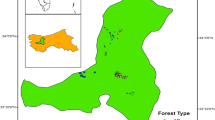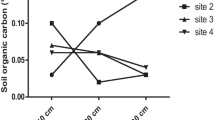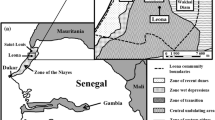Abstract—
This study aimed to evaluate subsoil carbon stock in different stands of riparian forests. Four different sites in the studied riparian forests located in Behbahan in southern Iran, pure Populus euphratica, Tamarix arceuthoides stands, and mixed T. arceuthoides-P. euphratica stands as well as agricultural lands were examined. One hundred and three soil samples were randomly taken at depths of 0–20 cm from all studied sites. Soil carbon content and the physiochemical properties pH, organic carbon, nitrogen, phosphorus, potassium, calcium carbonate, bulk density, and soil texture were determined in the laboratory. The results indicated that soil carbon stocks reach 52.9, 48.5, 25.9, and 25.8 t ha–1 in P. euphratica stands, agricultural lands, mixed T. arceuthoides-P. euphratica stands, and T. arceuthoides stands, respectively. There was no significant difference in soil carbon content between the P. euphratica stands and agricultural lands, but there was a significant difference between T. arceuthoides stands and mixed T. arceuthoides-P. euphratica stands. The high soil carbon content in agricultural lands was probably because of alfalfa and the use of organic fertilizer, like manure, because alfalfa was planted in most of the agricultural lands, and this plant species can store atmospheric nitrogen and, consequently, increase the carbon content in the soil. Furthermore, greater soil biological activity in the P. euphratica stands compared with the T. arceuthoides stands might be responsible for the higher soil carbon content in the P. euphratica stands. The physiochemical properties of soil also play important roles in soil carbon content, the most important of which are soil organic carbon, bulk density, and clay, respectively.



Similar content being viewed by others

Change history
20 April 2021
An Erratum to this paper has been published: https://doi.org/10.1134/S1064229321300013
REFERENCES
A. Buras, N. Thevs, S. Zerbe, and M. Wilmking, “Productivity and carbon sequestration of Populus euphratica at the Amu River, Turkmenistan,” Forestry 86, 429–439 (2013).
A. Walkley and I. A. Black, “An examination of the Degtjareff method for determining organic carbon in soils: effect of variations in digestion conditions and of inorganic soil constituents,” Soil Sci. 63, 251–263 (1951).
B. Bolin, R. Sukumar, P. Ciais, W. Cramer, P. Jarvis, H. Kheshgi, C. Nobre, S. Semenov, and W. Steffen, “Global perspective,” in Land Use, Land-Use Change, and Forestry, Ed. by R. Watson, (Cambridge University Press, Cambridge, 2000), pp. 23–52.
B. G. Johnson, P. S. J. Verburg, and J. A. Arnone, “Plant species effects on soil nutrients and chemistry in arid ecological zones,” Oecologia 182, 299–317 (2016).
C. Augustin and L. J. Cihacek, “Relationships between soil carbon and soil texture in the northern great plains,” Soil Sci. 181 (8), 386–392 (2016).
D. G. Williams, R. L. Scott, T. E. Huxman, D. C. Goodrich, and G. Lin, “Sensitivity of riparian ecosystems in arid and semiarid environments to moisture pulses,” Hydrol. Process. 20, 3191–3205 (2006).
D. T. Patten, “Riparian ecosystems of semi-arid North America: diversity and human impacts,” Wetlands 18, 498–512 (1998).
E. S. Krull, J. A. Baldock, and J. O. Skjemstad, “Soil texture effects on decomposition and soil carbon storage,” in Net Ecosystem Exchange: Cooperative Research, Ed. by M. Kirschbaum and R. Mueller (CRC for Greenhouse Accounting, Canberra, 2001), pp. 103–110.
E. S. Verry, J. W. Hornbeck, and C. A. Dolloff, Riparian Management in Forests of the Continental Eastern United States (CRC Press, Boca Raton, Fl, 2000), pp. 1–393.
F. Wang, Z. Li, H. Xia, B. Zou, N. Li, J. Liu, and W. Zhu, “Effects of nitrogen-fixing and non-nitrogen-fixing tree species on soil properties and nitrogen transformation during forest restoration in southern China,” Soil Sci. Plant Nutr. 56 (2), 297–306 (2010).
Gh. Moradi and H. Vacik, “Relationship between vegetation types, soil and topography in southern forests of Iran,” J. For. Res. 29 (6), 1635–1644 (2018).
Gh. Moradi, M. R. Marvie Mohadjer, Gh. Zahedi Amiri, A. Shirvany, and N. Zargham, “Life form and geographical distribution of plants in Posthband region, Khonj, Fars Province, Iran,” J. For. Res. 21 (2), 201–206 (2010).
H. D. Morwin and M. Peach, “Exchangeability of soil potassium in the sand, silt and clay fractions as influenced by the nature of the complementary exchangeable cation,” Soil Sci. Soc. Am. J. 15, 125–128 (1951).
H. Sohrabi, S. Bakhtiarvand-Bakhtiari, and K. Ahmadi, “Above- and below-ground biomass and carbon stocks of different tree plantations in central Iran,” J. Arid Land 8 (1), 138–145 (2016).
J. A. Foley, R. DeFries, G. P. Asner, C. Barford, G. Bonan, S. R. Carpenter, F. S. Chapin, M. T. Coe, G. C. Daily, H. K. Gibbs, J. H. Helkowski, T. Holloway, E. A. Howard, C. J. Kucharik, C. Monfreda, et al., “Global consequences of land use,” Science 309, 570–574 (2005).
J. E. B. Mouw, J. A. Stanford, and P. B. Alaback, “Influences of flooding and hyporheic exchange on floodplain plant richness and productivity,” River Res. Appl. 25, 929–945 (2009).
J. F. Reynolds, “Desertification,” in Encyclopedia of Biodiversity, Ed. by S. Levin (Academic, San Diego, CA, 2001), Vol. 2, pp. 61–78.
J. M. Bremner, and C. S. Mulvaney, “Nitrogen total,” in Method of Soil Analysis, Part 2: Chemical and Microbiological Methods, Ed. by R. H. Miller and D. R. Kieney (American Society for Agronomy and Soil Sciences, Madison, WI, 1982), pp. 595–624.
J. Mirzaei, M. Moradi, and F. Seyedi, “Carbon sequestration in the leaf, litter and soil of eucalyptus camaldulensis, Prosopis juliflora and Ziziphus spina-christi species,” Ecopersia 4 (3), 1481–1491 (2016).
J. Six and K. Paustian, “Aggregate-associated soil organic matter as an ecosystem property and a measurement tool,” Soil Biol. Biochem. 68, A4–A9 (2014).
K. E. Dybala, V. Matzek, T. Gardali, and N. E. Seavy, “Carbon sequestration in riparian forests: a global synthesis and meta-analysis,” Global Change Biol. 25, 57–67 (2019).
L. A. B. Giese, W. M. Aust, R. K. Kolka, and C. C. Trettin, “Biomass and carbon pools of disturbed riparian forests,” For. Ecol. Manage. 180, 493–508 (2003).
L. Batlle-Bayer, N. H. Batjes, and P. S. Bindraban, “Changes in organic carbon stocks upon land use conversion in the Brazilian Cerrado: a review,” Agric. Ecosyst. Environ. 137 (1–2), 47–58 (2010).
L. Omoro, M. Starr, and P. K. Pellikka, “Tree biomass and soil carbon stocks in indigenous forests in comparison to plantations of exotic species in the Taita Hills of Kenya,” Silva. Fenn. 47 (2), 935 (2013).
L. Rustad, J. Campbell, G. Marion, R. Norby, M. Mitchell, A. Hartley, J. Cornelissen, and J. Gurevitch, “A meta-analysis of the response of soil respiration, net nitrogen mineralization, and aboveground plant growth to experimental ecosystem warming,” Oecologia 126, 543–562 (2001).
L. Vesterdal, N. Clarke, B. D. Sigurdsson, and P. Gundersen, “Do tree species influence soil carbon stocks in temperate and boreal forests?” For. Ecol. Manage. 309, 4–18 (2013).
M. J. Salinas, G. Blanca, and A. T. Romero, “Evaluating riparian vegetation in semi-arid Mediterranean watercourses in the south-eastern Iberian Peninsula,” Environ. Conserv. 27 (1), 24–35 (2000).
M. Lemenih, E. Karltun, and M. Olsson, “Assessing soil chemical and physical property responses to deforestation and subsequent cultivation in smallholders farming system in Ethiopia,” Agric. Ecosist. Environ. 105, 373–386 (2005).
M. Moradi, F. Imani, H. R. Naji, S. Moradi Behbahani, and M. T. Ahmadi, “Variation in soil carbon stock and nutrient content in sand dunes after afforestation by Prosopis juliflorain the Khuzestan province (Iran),” iForest 10, 585–589 (2017).
M. Moradi, H. R. Naji, F. Imani, S. Moradi Behbahani, and M. T. Ahmadi, “Arbuscular mycorrhizal fungi changes by afforestation in sand dunes,” J. Arid Environ. 140, 14–19 (2017).
M. Pato, A. Salehi, Gh. Zahedi Amiri, and A. Banj Shafiei, “Soil carbon stock and its relationship with physical and chemical characteristics in soil of different land-uses in Zagros region,” J. For. Wood Prod. 69 (4), 747–756 (2017).
M. T. Vasbieva, “Effect of long-term application of organic and mineral fertilizers on the organic carbon content and nitrogen regime of soddy-podzolic soil,” Eurasian Soil Sci. 52, 1422–1428 (2019). https://doi.org/10.1134/S1064229319110139
N. Haghdoost, M. Akbarinia, and S. M. Hosseini, “Land-use change and carbon stocks: a case study, Noor County, Iran,” J. For. Res. 24, 461–469 (2013).
N. Thevs, S. Zerbe, A. Buras, E. Kuhnel, N. Abdusalih, and A. Ovezberdyyeva, “Structure and wood biomass of near-natural floodplain forests along the Central Asian rivers Tarim and Amu River,” Forestry 85, 193–202 (2012).
P. R. Day, “Particle fractionation and particle size analysis,” in Methods of Soil Analysis, Part 1: Physical and Mineralogical Methods, Agronomy Monograph Series no. 9.1, Ed. by A. Klute (American Society for Agronomy and Soil Sciences, Madison, WI, 1965), pp. 545–566.
R. Jandl, M. Lindner, L. Vesterdal, B. Bauwens, R. Baritz, F. Hagedorn, D. W. Johnson, K. Minkkinen, and K. A. Byrne, “How strongly can forest management influence soil carbon sequestration?” Geoderma 137, 253–268 (2007).
R. Lal, “Global potential of soil carbon sequestration to mitigation the greenhouse effect,” Crit. Rev. Plant Sci. 22 (2), 151–184 (2004).
S. Bhandari and S. Bam, “Comparatives study of soil organic carbon (SOC) under forest, cultivated and barren land: a case of Chovar Village, Kathmandu,” Nepal J. Sci. Technol. 14 (2), 103–108 (2013).
S. Moradi Behbahani, M. Moradi, R. Basiri, and J. Mirzaei, “Sand mining disturbances and their effects on the diversity of arbuscular mycorrhizal fungi in a riparian forest of Iran,” J. Arid Land. 9 (6), 837–849 (2017).
S. R. Olsen, C. V. Cole, F. S. Watanabe, and L. A. Dean, Estimation of Available Phosphorus in Soils by Extraction with Sodium Bicarbonate, USDA Circular vol. 939 (US Department of Agriculture, Washington, DC, 1954), pp. 1–19.
T. N. Hollingsworth, A. G. Schuur, F. S. Chapin, and M. D. Walker, “Plant community composition as a predictor of regional soil carbon storage in Alaskan boreal black spruce ecosystems,” Ecosystems 11, 629–642 (2008).
U. Mishra, R. Lal, B. Slater, F. Calhoun, D. Liu, and M. van Meirvenne, “Predicting soil organic carbon stock using profile depth distribution functions and ordinary kriging,” Soil Sci. Soc. Am. J. 73 (2), 614–621 (2009).
V. I. Nikitishen and V. I. Lichko, “Nitrogen budget in agroecosystems on gray forest soils under long-term fertilization,” Eurasian Soil Sci. 41, 429–440 (2008). https://doi.org/10.1134/S1064229308040091
X. Wei, M. Shao, W. Gale, and L. Li, “Global pattern of soil carbon losses due to the conversion of forests to agricultural land,” Sci. Rep. 4, 4062 (2014).
X. Y. Sun, G. X. Wang, M. Huang, R. Y. Chang, and F. Ran, “Forest biomass carbon stocks and variation in Tibet’s carbon-dense forests from 2001 to 2050,” Sci. Rep. 6, 34687 (2016). https://doi.org/10.1038/srep34687
Y. Yang, Y. Chen, Z. Li, and Y. Chen, “Land-use/cover conversion affects soil organic-carbon stocks: a case study along the main channel of the Tarim River, China,” PloS One 13 (11), e0206903 (2018).
Z. Avazpoor, M. Moradi, R. Basiri, J. Mirzaei, R. Taghizadeh-Mehrjardi, and R. Kerry, “ Soil enzyme activity variations in riparian forests in relation to plant species and soil depth,” Arab. J. Geosci. 12, 708 (2019). https://doi.org/10.1007/s12517-019-4910-2
ACKNOWLEDGMENTS
Special thanks to the Behbahan Khatam Alanbia University of technology and its staffs for their support during this work. Ruhollah Taghizadeh-Mehrjardi has been supported by the Alexander von Humboldt Foundation under the grant number: Ref3.4-1164573-IRN-GFHERMES-P.
Author information
Authors and Affiliations
Corresponding author
Ethics declarations
The authors declare that they have no conflict of interest.
Additional information
The original online version of this article was revised: The name of the fourth author should read R. Taghizadeh-Mehrjardi.
Rights and permissions
About this article
Cite this article
Forogh Nasab, M., Moradi, M., Moradi, G. et al. Topsoil Carbon Stock and Soil Physicochemical Properties in Riparian Forests and Agricultural Lands of Southwestern Iran. Eurasian Soil Sc. 53, 1389–1395 (2020). https://doi.org/10.1134/S1064229320100075
Received:
Revised:
Accepted:
Published:
Issue Date:
DOI: https://doi.org/10.1134/S1064229320100075



